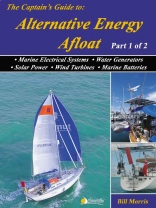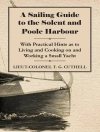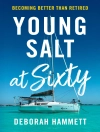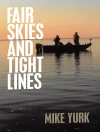This is Part 1 of 2 of The Captain’s Guide to Alternative Energy Afloat.
Part 1 covers the following topics:
• Main Power Plant
• Engine Alternators
• Gas & Diesel Generator Sets
• Alternative Fuels
• Cranking and House Batteries
• Solar Panels
• Wind Generators
• Hydro Generators
• Voltage Regulators and Controllers
• Monitoring Systems
A successful ocean passage on a small to midsize sailing vessel means keeping things as simple as possible. Sun, Wind, & Water: The Essential Guide to the Energy-Efficient Cruising Boat gives you the most detailed, up-to-date advice on how to prepare your boat for an ocean crossing while at the same time saving money and ensuring a smaller footprint on Mother Nature.
Circumnavigator-author Bill Morris describes in detail the best options for reducing dependence on fossil fuels, minimizing battery usage, and enjoying a comfortable lifestyle on the water. He presents an array of electrical charging systems, power-saving electrical fixtures, and manual devices aimed at saving money on fuel, along with pointers on installation and maintenance. This practical guide covers:
• The development of an energy-saving plan for your boat
• Battery technology and hydrogen fuel cells
• Charging batteries from sun, wind, and water power
• Battery charge control systems
• Effective refrigeration options for the tropics
• Autopilots and windvane self-steering
• Energy-saving systems on three successful blue water vessels
• And much, much more…
Bill Morris, author of The Windvane Self-Steering Handbook and a frequent contributor to Ocean Navigator Magazine, currently cruises the Channel Islands of Southern California on the 1966 Cal 30 Saltaire as he prepares for his next offshore adventure.
Tabla de materias
Contents
Foreword
Acknowledgements
Introduction
1. Main Power Plant
Gasoline Engines
Diesel Engines
Repowering with Diesel
Electric Propulsion
Hybrid Electric Power
2. Engine Alternators
How Generators and Alternators Work
Selecting an Alternator
External Controllers
Basic Troubleshooting
3. Gas & Diesel Generator Sets
Optimum Power
Dimensions and Layout
Engine Manufacturer
Engine Performance
Load Surge Protection
Sound Shield
Traditional Genset: Westerbeke
Belt Drive: Next Generation
Asynchronous: Fischer Panda
Fuel-Injected Gasoline: Kohler
Hybrid Genset: Mastervolt
Got Juice?
4. Alternative Fuels
Petroleum Distillates
Ethanol
Low Sulfur Diesel
Biodiesel
Home-Made Biodiesel
Complications of Biodiesel
Liquid Petroleum Gas
Gasoline-LPG Conversions
5. Cranking and House Batteries
Cranking, House, and Dual-Purpose Batteries
Battery Ratings
Flooded Batteries
AGM
Carbon Foam
Gel
Lithium-Ion
Fuel Cells
Optimum Combinations
Installing Batteries
6. Solar Panels
Photovoltaic Energy
Rigid Solar Panels
Flexible Solar Panels
Non-Marine Panels
Electrical Installation
Mounting Techniques
7. Wind Generators
Theory
Design Features
Leading Models
Deck and Arch Mounting
Installation Kits
Other Considerations
8. Hydro Generators
Advantages of Water Power
Design and Construction
Towed Water Turbine
Wind-Water Conversions
Towline-Free Hydro Generators
Experimental Technology
9. Voltage Regulators and Controllers
Voltage Regulators
Smart Controllers
Switches, Isolators, and Solenoids
10. Monitoring Systems
Analog and Digital Monitoring
Engine Monitoring
Battery Monitoring
Monitoring Charge Sources
Additional Monitoring Devices
References
Appendices
Appendix 1: AWG Battery Cable Sizes
Appendix 2: AWG Wire Gauge Sizes
Appendix 3: Beaufort Scale
Appendix 4: Cruiser’s Ham Bands
Appendix 5: Marine Fire Extinguishers
Appendix 6: Sailboat Specifications Decoded
Special Thanks
About the Author
Sobre el autor
Circumnavigator-author Bill Morris, a native of Los Angeles, received his first inspiration to sail the world’s oceans at the age of twelve when his father offhandedly suggested selling the house and circling the globe aboard a large yacht.
Though the proposal was soon abandoned, the idea was permanently engraved in Bill’s imagination. Serving as a radio repairman and later as an outboard motor mechanic in the U.S. Army while stationed in the Panama Canal Zone during the mid-1970s, he picked up valuable skills that would help him later in life as a cruising sailor.
He went on to receive a Ph.D. in Administrative and Policy Studies in Education from UCLA, amassing nearly 30 years’ experience in teaching writing at the secondary and college levels in Southern California, South Florida, and American Samoa. Bill and his wife Marilu eventually crossed the Pacific from Panama to Mooloolaba Harbour, Queensland, Australia, and then to Darwin, Northern Territory, aboard their 1966 Cal 30 Saltaire.
After Marilu left Saltaire to give birth to their daughter, Yasmin, Bill continued west back to Los Angeles by way of the two canals, surviving a Somali pirate attack in the Gulf of Aden. Bill is the author of The Windvane Self-Steering Handbook (International Marine, 2004), and he has written many articles on both cruising adventure and alternative energy for offshore vessels in Afloat, Blue Water Sailing, Latitude 38, Ocean Navigator, and Ocean Voyager magazines.












